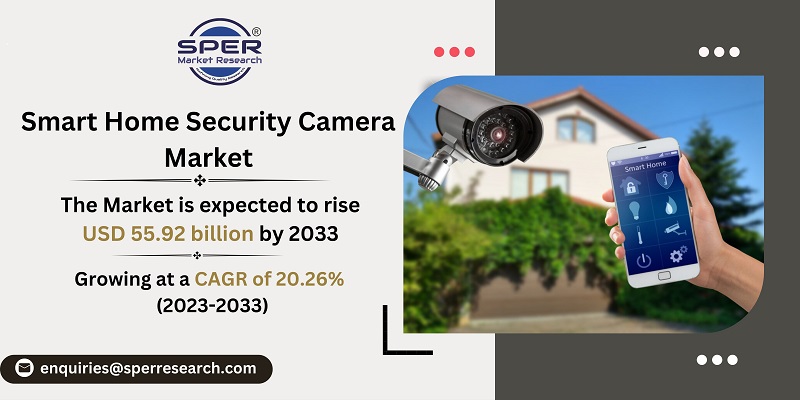
Smart Home Security Camera Market Growth, Trends, Size, Revenue, Scope and Future Challenges
Smart Home Security Camera Market Size- By Product, By Type- Regional Outlook, Competitive Strategies and Segment Forecast to 2033
| Published: Aug-2023 | Report ID: IACT23146 | Pages: 1 - 224 | Formats*: |
| Category : Information & Communications Technology | |||
- Growing Awareness and acceptance: As consumers become more worried about home security, there has been an increase in the awareness and acceptance of smart home security cameras. With increased media coverage of burglaries and home invasions, people are looking for methods to improve their home security, fueling demand for smart home security solutions.
- Growing Safety and Security Concerns: Growing safety, security, and privacy concerns have fueled demand for smart home security cameras. People want to secure their homes, property, and loved ones, and smart cameras provide a proactive solution to this problem.


| Report Metric | Details |
| Market size available for years | 2019-2033 |
| Base year considered | 2022 |
| Forecast period | 2023-2033 |
| Segments covered | By Product, By Type |
| Regions covered | Asia-Pacific, Europe, Middle East and Africa, North America, Latin America |
| Companies Covered | ADT LLC, Arlo Technologies Inc., Blink, Brinks Home Security, Frontpoint Security Solutions LLC, Samsung Electronics Co. Ltd, Simplisafe Inc., Skylinkhome, Vivint Smart Home Inc. |
- Homeowners
- Renters
- Business Owners
- Security-Conscious Consumers
| By Product: |
|
| By Type: |
|
- Global Smart Home Security Camera Market Size (FY’2023-FY’2033)
- Description of Global Smart Home Security Camera Market
- Segmentation of Global Smart Home Security Camera Market By Product (Wired Cameras, Wireless Cameras)
- Segmentation of Global Smart Home Security Camera Market By Type (Doorbell Cameras, Indoor Cameras, Outdoor Cameras)
- Statistical Snap of Global Smart Home Security Camera Market
- Expansion Analysis of Global Smart Home Security Camera Market
- Problems and Obstacles in Global Smart Home Security Camera Market
- Competitive Landscape in the Global Smart Home Security Camera Market
- Impact of COVID-19 and Demonetization on Global Smart Home Security Camera Market
- Details on Current Investment in Global Smart Home Security Camera Market
- Competitive Analysis of Global Smart Home Security Camera Market
- Prominent Players in the Global Smart Home Security Camera Market
- SWOT Analysis of Global Smart Home Security Camera Market
- Global Smart Home Security Camera Market Future Outlook and Projections (FY’2023-FY’2033)
- Recommendations from Analyst
1.1. Scope of the report1.2. Market segment analysis
2.1. Research data source2.1.1. Secondary Data2.1.2. Primary Data2.1.3. SPER’s internal database2.1.4. Premium insight from KOL’s2.2. Market size estimation2.2.1. Top-down and Bottom-up approach2.3. Data triangulation
4.1. Driver, Restraint, Opportunity and Challenges analysis4.1.1. Drivers4.1.2. Restraints4.1.3. Opportunities4.1.4. Challenges4.2. COVID-19 Impacts of the Global Smart Home Security Camera Market
5.1. SWOT Analysis5.1.1. Strengths5.1.2. Weaknesses5.1.3. Opportunities5.1.4. Threats5.2. PESTEL Analysis5.2.1. Political Landscape5.2.2. Economic Landscape5.2.3. Social Landscape5.2.4. Technological Landscape5.2.5. Environmental Landscape5.2.6. Legal Landscape5.3. PORTER’s Five Forces5.3.1. Bargaining power of suppliers5.3.2. Bargaining power of buyers5.3.3. Threat of Substitute5.3.4. Threat of new entrant5.3.5. Competitive rivalry5.4. Heat Map Analysis
6.1. Global Smart Home Security Camera Market Manufacturing Base Distribution, Sales Area, Product Type6.2. Mergers & Acquisitions, Partnerships, Product Launch, and Collaboration in Global Smart Home Security Camera Market
7.1. Global Smart Home Security Camera Market Value Share and Forecast, By Product, 2023-20337.2. Wired Cameras7.3. Wireless Cameras
8.1. Global Smart Home Security Camera Market Value Share and Forecast, By Type, 2023-20338.2. Doorbell Cameras8.3. Indoor Cameras8.4. Outdoor Cameras
9.1. Global Smart Home Security Camera Market Size and Market Share
10.1. Global Smart Home Security Camera Market Size and Market Share By Product (2019-2026)10.2. Global Smart Home Security Camera Market Size and Market Share By Product (2027-2033)
11.1. Global Smart Home Security Camera Market Size and Market Share By Type (2019-2026)11.2. Global Smart Home Security Camera Market Size and Market Share By Type (2027-2033)
12.1. Global Smart Home Security Camera Market Size and Market Share By Region (2019-2026)12.2. Global Smart Home Security Camera Market Size and Market Share By Region (2027-2033)12.3. Asia-Pacific12.3.1. Australia12.3.2. China12.3.3. India12.3.4. Japan12.3.5. South Korea12.3.6. Rest of Asia-Pacific12.4. Europe12.4.1. France12.4.2. Germany12.4.3. Italy12.4.4. Spain12.4.5. United Kingdom12.4.6. Rest of Europe12.5. Middle East and Africa12.5.1. Kingdom of Saudi Arabia12.5.2. United Arab Emirates12.5.3. Rest of Middle East & Africa12.6. North America12.6.1. Canada12.6.2. Mexico12.6.3. United States12.7. Latin America12.7.1. Argentina12.7.2. Brazil12.7.3. Rest of Latin America
13.1. ADT LLC13.1.1. Company details13.1.2. Financial outlook13.1.3. Product summary13.1.4. Recent developments13.2. Arlo Technologies Inc.13.2.1. Company details13.2.2. Financial outlook13.2.3. Product summary13.2.4. Recent developments13.3. Blink13.3.1. Company details13.3.2. Financial outlook13.3.3. Product summary13.3.4. Recent developments13.4. Brinks Home Security13.4.1. Company details13.4.2. Financial outlook13.4.3. Product summary13.4.4. Recent developments13.5. Frontpoint Security Solutions LLC13.5.1. Company details13.5.2. Financial outlook13.5.3. Product summary13.5.4. Recent developments13.6. Samsung Electronics Co. Ltd13.6.1. Company details13.6.2. Financial outlook13.6.3. Product summary13.6.4. Recent developments13.7. Simplisafe Inc.13.7.1. Company details13.7.2. Financial outlook13.7.3. Product summary13.7.4. Recent developments13.8. Skylinkhome13.8.1. Company details13.8.2. Financial outlook13.8.3. Product summary13.8.4. Recent developments13.9. Vivint Smart Home Inc.13.9.1. Company details13.9.2. Financial outlook13.9.3. Product summary13.9.4. Recent developments13.10. Others
SPER Market Research’s methodology uses great emphasis on primary research to ensure that the market intelligence insights are up to date, reliable and accurate. Primary interviews are done with players involved in each phase of a supply chain to analyze the market forecasting. The secondary research method is used to help you fully understand how the future markets and the spending patterns look likes.
The report is based on in-depth qualitative and quantitative analysis of the Product Market. The quantitative analysis involves the application of various projection and sampling techniques. The qualitative analysis involves primary interviews, surveys, and vendor briefings. The data gathered as a result of these processes are validated through experts opinion. Our research methodology entails an ideal mixture of primary and secondary initiatives.



Frequently Asked Questions About This Report
PLACE AN ORDER
Year End Discount
Sample Report
Pre-Purchase Inquiry
NEED CUSTOMIZATION?
Request CustomizationCALL OR EMAIL US
100% Secure Payment






Related Reports
Our Global Clients
Our data-driven insights have influenced the strategy of 200+ reputed companies across the globe.




















